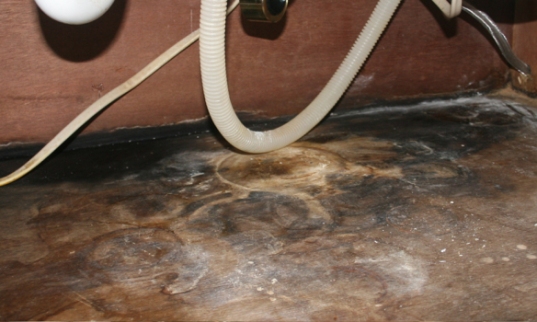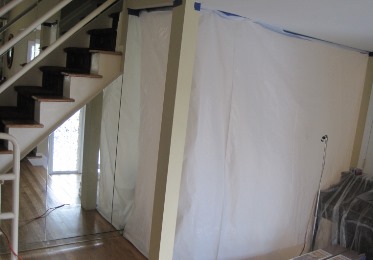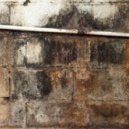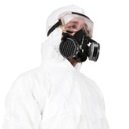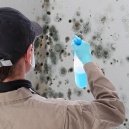Find a pre-screened local mold removal specialist Free Estimate
Find a Mold Specialist Now
Click or Call, Toll-Free 24/7
Cleaning Black Mold
Cleaning up any mold problem can be a complicated affair, but cleaning black mold can be dangerous to anyone in the affected areas; workers, residents, bystanders, even pets. In fact, “cleaning” is a bit of a misnomer. Removing (cleaning) black mold, or any type of mold for that matter, is serious business and should be undertaken only after careful thought and planning. There are many molds that are black in color and several of them can be toxic. Serious health issues can arise if the proper planning, execution of the removal process, and post removal cleaning isn’t completed properly.
When the first humans arrived they lived outdoors. Mold in the environment was never an issue unless it was ingested. Then people learned that it was better to have shelter and along came tents, then huts, then simple buildings, and finally the homes and buildings we live and work in today. And that is when cleaning mold, particularly black mold, became a major concern.
The Health Risks of Black Mold
Exposure to black mold can cause a variety of negative health effects. Because some individuals are more sensitive to the effects of mold than others, it is never a certainty who will be affected and in what way their body will respond to exposure to black mold. Exposure to mold can cause throat irritation, nasal congestion, coughing, and eye irritation. More sensitive people can develop asthma-like conditions, respiratory infections and nerve disorders, even to the point of becoming life threatening. Anyone exposed to black mold or attempting to clean black mold can be at risk.
Proper Job Sequencing For Cleaning Black Mold
Mold is everywhere, thankfully. It is nature’s way of “cleaning” the environment. Unfortunately, mold doesn’t know the difference between a dead tree in the forest and the 2x4 studs we use to build our homes. If mold gets a chance, under the right conditions (water, warmth, lack of bright light, and an organic food source), it will attempt to do the job it was designed for, decomposition.
Because black mold spores are of a very small size, they become a major concern for anyone attempting to remove them or clean them. The proper remediation steps listed below are of the utmost importance:
- Identifying and stopping the source of any moisture.
- Establishing containment of any and all areas affected by the mold.
- Setting up and maintaining negative air pressures.
- Removal of contaminated materials, both structural and personal.
- Cleaning any remaining surfaces that have been exposed to the mold.
- Drying the affected areas.
- Conducting a post-remediation evaluation to determine results.
Primary Setup For Cleaning Black Mold
Without a doubt, the first thing a person needs to do is to find the source of any moisture intrusion and eliminate it. This could be anything from stopping a roof leak to fixing the dripping plumbing to solving a basement humidity issue. No one and no thing, including mold, can survive and thrive without water. Sometimes finding that source can be difficult, but it must be accomplished first.
The second step is to isolate and contain any areas contaminated by mold. This can be as simple as closing doors and blocking heat registers to the more complex containment chambers built with 6 mil plastic, sturdy tape, and zippered entry and exit points. Proper and effective containment is a key ingredient to a successful and safe remediation project.

Once containment has been achieved, the third step is to make sure no mold spores that may become airborne during the removal of contaminated materials are allowed to escape the contained area. This is usually done with negative air pressure. When there is “less” air inside the containment, the direction of airflow will always move into the contained area. Any dislodged black mold spores that float near an exit point will be “sucked” back into the room and prevented from escaping. This negative airflow needs to be maintained throughout the entire cleaning process and kept in place at least 48 hours after the cleaning has been completed.
The Actual Removal and Cleaning of Black Mold
Once the above conditions have been completed, it’s time to get down to the business of removing and cleaning the black mold. So, it’s time to suit up. Disposable coveralls, gloves, eye protection, and respirators are required for workers cleaning black mold. Everything that has come into contact with black mold and its spores must be either removed or cleaned. For most porous materials such as drywall, fabrics, and carpeting, they should be placed into heavy-duty plastic bags and discarded (exceptions for highly-valued items can be made IF they can be successfully and professionally cleaned).
All remaining materials, studs, wooden subfloors, and other non-porous materials need to be HEPA vacuumed, possibly dusted, wire brushed, or sanded to dislodge any mold, HEPA vacuumed a second time, and damp wiped with an antimicrobial cleanser.
Final Steps for Cleaning Black Mold
After removing the mold and damp wiping remaining surfaces, drying the entire area and any remaining components must be done. A commercial grade dehumidifier and one or two air movers (fans) operating a low speed to gently “stir” the air are recommended. It is virtually impossible to remove all mold spores so it is important to eliminate any leftover humidity or moisture in structural materials. Follow-up drying is necessary because mold will not re-establish itself if there is a lack of adequate moisture.
The final step in any black mold cleaning project is clearance testing. This can be done in a variety of ways; surface sample testing, air testing, and particle counting are some of the more common methods. A point to be remembered is that the area or room does not have to be mold-free; the amounts and types of mold present should mirror the environment around your home. The types and concentrations of mold inside should closely match what is found outside.
Be Safe and Be Sure
Cleaning black mold isn’t for everyone. If you’re confident and have the proper understanding and equipment, you can attempt mold remediation on your own. There is a step-by-step guide available, “The Homeowner’s Complete Guide to Performing Mold Remediation” by Brian Turner that can provide details concerning personal safety and work practices necessary to successfully clean black mold. It is recommended reading for any do-it yourself person before starting a mold removal project.
However, it is always smart to seek professional guidance or assistance when dealing with any type of mold. We have made it easy to find a mold remediation professional in your area. These mold specialists will come to your home, view your problem, and come up with a plan to eliminate the mold. Their initial inspection is free of charge, with no further obligation on your part. Almost everyone can benefit from free advice.
Free Home Inspection By A Mold Removal Specialist
Search This Website
Free Home Inspection By A Mold Removal Specialist
Recent Articles
-
See Our 5 Recommended Mold Removal Companies in Covington, KY
Apr 16, 25 12:59 PM
-
See Our 5 Recommended Mold Removal Companies in Wheaton, IL
Jun 20, 24 10:33 AM
-
See Our 5 Recommended Mold Removal Companies in Aberdeen, SD
Oct 08, 21 04:05 PM
